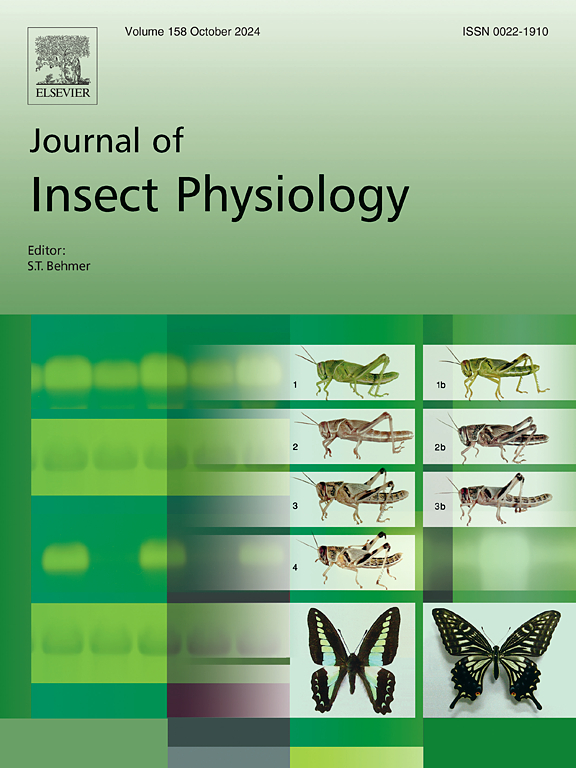Gene regulation by mating depends on time, diet, and body region in female Aedes aegypti
IF 2.3
2区 农林科学
Q1 ENTOMOLOGY
引用次数: 0
Abstract
Aedes aegypti is a major vector of several arboviruses that cause human mortality and morbidity. One method for controlling the spread of these viruses is to control mosquito reproduction. During mating, seminal fluid molecules and sperm are transferred and these stimuli influence female post-mating physiology and behavior. Yet, little is known about the mechanisms underlying these post-mating responses. To fill this gap, short-read RNA sequencing was used to identify differentially expressed genes between unmated (control) and mated females in the head/thorax (HT), abdomen (Ab) and the lower reproductive tract (LRT), of mosquitoes reared with 3% and 12% sucrose. The results revealed that at 3% sucrose, four, 408 and 415 significantly differential expressed genes (DEGs) were identified in the HT, Ab and LRT, respectively, at six hours post mating (hpm). The number of DEGs dropped dramatically at 24 hpm with no DEGs in the HT, three in the Ab, and 112 in the LRT. In contrast, the number of DEGs was lower at 6 hpm than 24 hpm in the LRT at 12% sucrose. Comparing our results to a similar study which used 10% sucrose revealed evidence in support of condition-dependent regulation of gene expression by mating in this species. This study shows that mating-induced transcriptional changes depend on time point after mating, body region, and diet. Our results provide foundational knowledge for future functional analyses to identify genes and pathways involved in the post-mating behavioral and physiological changes of female mosquitoes.

雌性埃及伊蚊的交配基因调控取决于时间、饮食和身体区域。
埃及伊蚊是导致人类死亡和发病的几种虫媒病毒的主要传播媒介。控制这些病毒传播的方法之一是控制蚊子的繁殖。在交配过程中,精液分子和精子会发生转移,这些刺激会影响雌性交配后的生理和行为。然而,人们对这些交配后反应的机制知之甚少。为了填补这一空白,研究人员使用短线程 RNA 测序来鉴定未交配(对照组)和交配雌蚊头部/胸部(HT)、腹部(Ab)和下生殖道(LRT)的差异表达基因。结果显示,在蔗糖含量为 3% 的条件下,交配后六小时(hpm),在头部/胸部、腹部和下生殖道中分别发现了 4 个、408 个和 415 个差异表达基因(DEGs)。交配后 24 小时,DEGs 数量急剧下降,HT 中没有 DEGs,Ab 中有 3 个,LRT 中有 112 个。相比之下,在蔗糖含量为12%的条件下,LRT中DEGs的数量在6 hpm时低于24 hpm时。将我们的研究结果与使用 10%蔗糖的类似研究结果进行比较后发现,有证据支持交配对该物种基因表达的调控具有条件依赖性。这项研究表明,交配诱导的转录变化取决于交配后的时间点、身体区域和饮食。我们的研究结果为今后的功能分析提供了基础知识,以确定参与雌蚊交配后行为和生理变化的基因和途径。
本文章由计算机程序翻译,如有差异,请以英文原文为准。
求助全文
约1分钟内获得全文
求助全文
来源期刊

Journal of insect physiology
生物-昆虫学
CiteScore
4.50
自引率
4.50%
发文量
77
审稿时长
57 days
期刊介绍:
All aspects of insect physiology are published in this journal which will also accept papers on the physiology of other arthropods, if the referees consider the work to be of general interest. The coverage includes endocrinology (in relation to moulting, reproduction and metabolism), pheromones, neurobiology (cellular, integrative and developmental), physiological pharmacology, nutrition (food selection, digestion and absorption), homeostasis, excretion, reproduction and behaviour. Papers covering functional genomics and molecular approaches to physiological problems will also be included. Communications on structure and applied entomology can be published if the subject matter has an explicit bearing on the physiology of arthropods. Review articles and novel method papers are also welcomed.
 求助内容:
求助内容: 应助结果提醒方式:
应助结果提醒方式:


